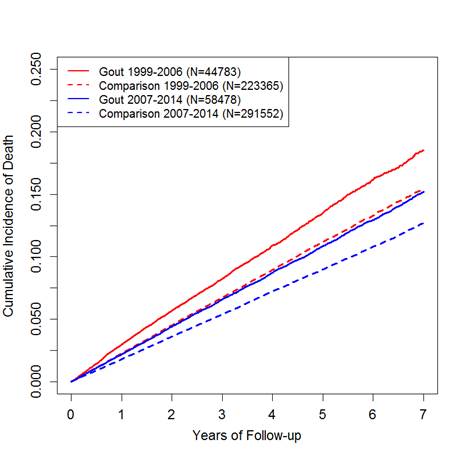Session Information
Session Type: ACR Concurrent Abstract Session
Session Time: 9:00AM-10:30AM
Background/Purpose: Gout and rheumatoid arthritis (RA), the two most common inflammatory arthritides, are both associated with premature mortality. General population-based studies have found substantially reduced premature deaths in RA patients in recent years (likely due to improved RA care), including our own study spanning 1999-2014 (1). However, no equivalent secular trend data in gout are available. Given the well-documented suboptimal gout care, opposing mortality trends may exist between RA and gout, as was recently shown in their hospitalization rates (2). We evaluated this hypothesis by examining mortality trends of gout patients over the same period (i.e., 1999-2014) as in our recent study based on the same general population database (1).
Methods: Using an EMR database representative of the UK general population, we identified incident gout cases and up to 5 non-gout controls matched on sex, age, and entry time between Jan 1 1999 and Dec 31 2014. The gout cohort was divided into two sub-cohorts based on the year of diagnosis, forming the early (1999-2006) and late (2007-2014) cohorts. We calculated mortality rates and hazard ratios (HRs) using a Cox proportional hazard model to adjust for demographics, lifestyle factors, comorbidities, medications, and healthcare use. We then compared the HRs from the early vs. late cohorts using interaction analyses. We repeated these analyses limited to those who received at least one prescription for urate-lowering therapy or colchicine, which has been found to have a validity of 90%.
Results: Both the early and late cohorts (N = 44,783 and 58,478, respectively) had the same mean age (62 years) and sex proportion (~74% male) between the gout and comparison group. In both the early and late cohorts, gout patients showed similar levels of excess mortality compared to their corresponding comparison cohort (i.e., 29.1 vs. 23.5 deaths/1000 person-years (PY) in the early cohort and 23.0 vs. 18.8 deaths/1000 PY in the late cohort) (Figure). The corresponding univariate mortality HRs (95% CI) were 1.25 (1.21-1.30) and 1.24 (1.20-1.29), and the multivariable mortality HRs were 1.10 (1.06-1.15) and 1.09 (1.05-1.13), respectively (both P for interaction >0.72). Our analysis limited to those who received a prescription for anti-gout medication showed similar findings (both P for interaction >0.88)
Conclusion: This population-based cohort study indicates that the level of excess mortality among gout patients remains unchanged over the past 16 years, contrasting the aforementioned substantial reduction in excess mortality observed among RA patients during the same period (1). This unclosing gap in premature mortality among gout patients calls for improved management of gout and its comorbidities. References:
1. Ann Rheum Dis. doi: 10.1136/annrheumdis-2016-205269 (Epub ahead of print).
To cite this abstract in AMA style:
Rai SK, Lu L, Zhang Y, Choi HK. Secular Trend of Premature Mortality in Gout: A Contrast from Rheumatoid Arthritis [abstract]. Arthritis Rheumatol. 2016; 68 (suppl 10). https://acrabstracts.org/abstract/secular-trend-of-premature-mortality-in-gout-a-contrast-from-rheumatoid-arthritis/. Accessed .« Back to 2016 ACR/ARHP Annual Meeting
ACR Meeting Abstracts - https://acrabstracts.org/abstract/secular-trend-of-premature-mortality-in-gout-a-contrast-from-rheumatoid-arthritis/

